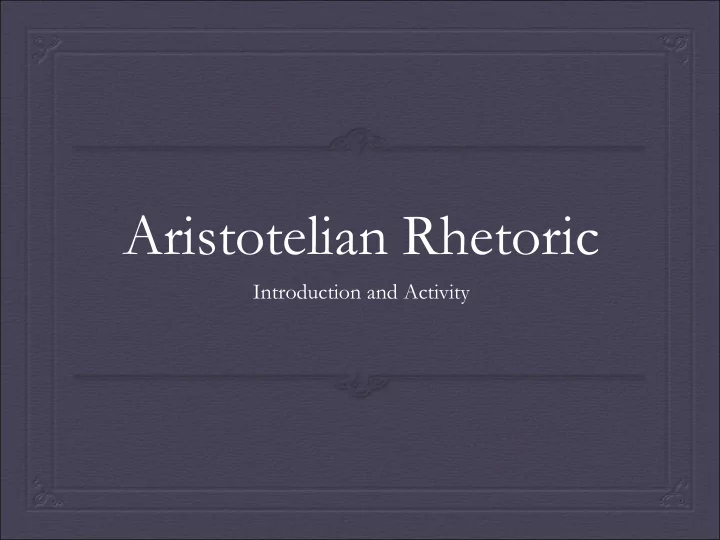

Aristotelian Rhetoric Introduction and Activity
So what is rhetoric? Rhetoric has to do with the art of persuasion and argument — how a writer persuades his or her audience using different rhetorical techniques The Greek philosopher Aristotle divided this means of persuasion into three appeals — ethos, logos, and pathos. We can use these terms when looking at different texts in order to understand the different ways authors are appealing to their audiences, how they are attempting to effectively appeal to their audience rhetorically. Source: http://courses.durhamtech.edu/perkins/aris.html
Ethos, Logos, and Pathos Ethos (Credibility): We tend to believe and listen to people whom we respect. Ethos is a rhetorical appeal that focuses on the credibility and authority of the author. Logos (Logic): Logos appeals to a reader ’ s sense of logic within the argument, the argument ’ s consistency and the author ’ s effective use of outside materials/sources in bolstering his or her own claims. Pathos (Emotion): Appealing to a reader ’ s emotions can be a very effective way to get him or her to see and understand an author ’ s argument. Pathos appeals to reader ’ s sympathies through things like personal anecdote and emotional/vivid language. Source: http://courses.durhamtech.edu/perkins/aris.html
Let ’ s Apply These Terms to a Text! Watch the following videos and take notes on the following questions: Who do you think the target audience is for these videos? What is the purpose of each? How are ethos, logos, and pathos used in these videos? How are they used similarly, differently? Are they used effectively to persuade the target audience? Why/why not? Consider the visual, auditory, and written elements of each video and how all of these are used in order to persuade the audience of these text ’ s purpose http://www.youtube.com/watch?v=VMAVliYdE_I http://www.youtube.com/watch?v=pqvAM0tHTAA
Let ’ s Talk About What We Saw! Discuss what you ’ ve seen/written about with a partner. Be prepared to come together as a class and share what you have discussed with your peer. Here are some questions to consider: What was the purpose of the Sea World commercial? The Blackfish trailer? What were they trying to convince you of, what argument were they making? Who were the target audience(s) for these videos? Why do you think so? How was each video credible? How did they try to build up their authority? How did these videos appeal to their audience logically? What facts/statistics did they use in order to convince their audience of their argument? How did these videos appeal to their audience emotionally? What images, sounds, text, etc. did they use in order to achieve their purpose? Did these texts, overall, effectively persuade their audiences rhetorically? Why/why not?
Rhetorically Effective? A text can be effective rhetorically even if you disagree with the purpose/argument. Just because you disagree with something does not mean that it was argued poorly. These rhetorical strategies can help you consider how an argument is constructed and appeals to a certain audience. These two texts had the same subject matter but different purposes. They both dealt with orca whales in Sea World but wanted to convince their audiences of entirely different arguments. They used the same rhetorical strategies, ethos, logos, and pathos , in order to convince their audience of their argument. Although these appeals dealt with the same issues (credibility, logic, emotion), these texts used them in order to persuade the viewer of their own specific argument.
You Can Too! Not only can we discuss how other authors are using these rhetorical strategies in their work, but you can use ethos, logos, and pathos in your own writing in order to effectively convince your audience of your argument As you begin to determine your audience and content for your website, consider how you might appeal to your audience using emotion, credibility/authority, and logic. How might you incorporate these rhetorical appeals in to your own work in order to persuade your audience of your argument?
Recommend
More recommend